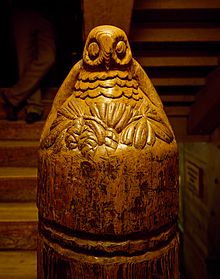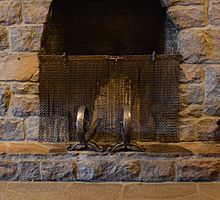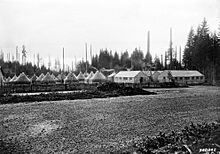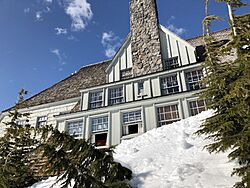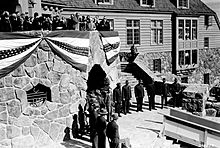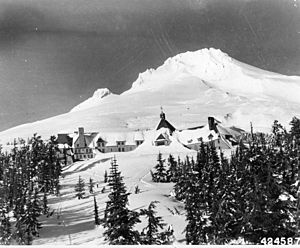Timberline Lodge facts for kids
|
Timberline Lodge
|
|
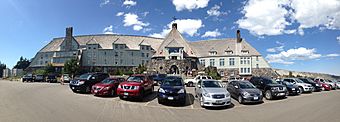
Timberline Lodge in 2014
|
|
| Nearest city | Government Camp, Oregon |
|---|---|
| Built | 1936–1938 |
| Architect | Gilbert Stanley Underwood, W. I. Turner, Linn A. Forrest, Howard L. Gifford, Dean R. E. Wright |
| Architectural style | Rustic Cascadian Neovernacular |
| NRHP reference No. | 73001572 |
Quick facts for kids Significant dates |
|
| Added to NRHP | November 12, 1973 |
| Designated NHL | December 22, 1977 |
Timberline Lodge is a cool mountain lodge located on the south side of Mount Hood in Clackamas County, Oregon. It's about 60 miles (97 km) east of Portland. This amazing building was constructed between 1936 and 1938. It was a special project by the Works Progress Administration (WPA), which was a government program that created jobs during the Great Depression. Local artists and workers built and furnished the lodge.
President Franklin D. Roosevelt officially opened Timberline Lodge on September 28, 1937. This lodge is a National Historic Landmark, which means it's a very important historical place. It sits high up at 6,000 feet (1,829 m) inside the Mount Hood National Forest. You can get there by driving on the Mount Hood Scenic Byway.
Timberline Lodge is owned by the public but run by a private company. It's a super popular spot for tourists, with about two million people visiting every year! You might even recognize it from the movies, as it was used for the outside of the Overlook Hotel in the film The Shining (1980).
The lodge also has a ski resort called Timberline Lodge. It has the longest skiing season in the U.S., staying open for skiers and snowboarders all year round! Besides skiing and snowboarding, you can also go snowshoeing, hiking, biking, and climbing here.
Contents
Building Timberline Lodge

Each workman on Timberline Lodge gained proficiency in manual arts. He was a better workman, a better citizen, progressing by infinitely-slow steps to the degree above him.
– The Builders of Timberline Lodge, Federal Writers' Project
Timberline Lodge is a four-story building that covers about 40,000 square feet (3,716 m2). The outside walls on the ground floor are made of heavy stone, using large rocks found right in the area. The upper floors use strong timber.
The main part of the lodge, called the head house, is shaped like a hexagon. It's 60 feet (18 m) across and has a tall stone chimney that's 90 feet (27 m) high and 14 feet (4 m) wide. This chimney has six large fireplaces, three on the ground floor and three on the first floor. Each fireplace opening is 5 feet (2 m) wide and 7 feet (2 m) high.
Two wings extend from the head house, one to the west and one to the southeast. The building uses many types of wood from Oregon, like cedar, Douglas fir, hemlock, western juniper, and ponderosa pine.
Who Designed It?
The main architect for Timberline Lodge was Gilbert Stanley Underwood. He was famous for designing other lodges in U.S. national parks, like the Ahwahnee Hotel. His original design for the central head house was an octagon, but it was changed to a hexagon by other architects from the U.S. Forest Service. These included W. I. (Tim) Turner, Linn A. Forrest, Howard L. Gifford, and Dean R. E. Wright. Ward Gano, a forest service engineer, designed the structure of the building.
Building During the Great Depression
Timberline Lodge was built as a Works Progress Administration (WPA) project during The Great Depression. This was a time when many people didn't have jobs. The WPA spent about $695,730 on the lodge, and 80% of that money went to paying workers. Skilled workers earned 90 cents an hour, while other laborers earned 55 cents an hour. Some of the skilled stonemasons were immigrants from Italy.
About 100 construction workers were on site at a time. They lived in a tent city nearby. Jobs were often rotated so that more people could get work.
The builders were very clever at using recycled materials to save money. Women wove curtains, furniture covers, and bedspreads. Rugs were made from old blankets from the Civilian Conservation Corps camps. Old cedar utility poles were turned into newel posts (the main posts at the end of a staircase railing), and their tops were carved into animals like birds, bears, and seals. Fireplace screens were made from old tire chains. Even the metal parts for the fireplaces were made from old railroad tracks! Workers used large timbers and local stone found right at the building site.
The WPA's Federal Writers' Project said that all kinds of workers helped with the project. This included people who used picks and shovels, stonecutters, plumbers, carpenters, painters, wood-carvers, and even artists and writers. Everyone worked together to create something special.
Art at the Lodge
The Federal Art Project also played a big part in the lodge's design. This project was led by Margery Hoffman Smith. She created many designs for the fabrics and rugs. She also designed the famous "snow goose," a 750-pound (340 kg) bronze weather vane that sits above the main building. Smith used designs from the local Tenino people for the patterns carved into the lodge's chimney. She also made sure the furniture, lamps, and other decorations fit the lodge's style. She hired other WPA artists from Oregon to create murals, paintings, and carvings for the lodge.
Lodge Dedication
President Franklin D. Roosevelt officially dedicated Timberline Lodge on September 28, 1937. He was on a trip to see government projects in the western U.S. In his speech, he talked about how the lodge was built by the WPA to create jobs and offer a fun place for people to visit.
He said that thousands of visitors would come to Mount Hood. They would see how the cattle ranches in eastern Oregon connect with the forests. They would also understand how the timber from the National Forest helps the lumber industry in places like Portland.
President Roosevelt also said that the lodge would offer new chances for fun all year round. He especially looked forward to people coming for skiing and tobogganing and other winter sports.
He dedicated the lodge by reading the words from a bronze plaque on the building. It said: "Timberline Lodge, Mount Hood National Forest dedicated September 28, 1937, by the President of the United States as a monument to the skill and faithful performance of workers on the rolls of the Works Progress Administration."
President Roosevelt and his wife, Eleanor Roosevelt, enjoyed a special lunch with salmon and huckleberry pie. Eleanor Roosevelt wrote in her newspaper column, My Day, about how much she liked the lodge's design. She praised how it was built only with local materials and by WPA workers. She especially liked the unique central fireplace and the huge timbers used. She also noted that all the furniture, curtains, and ironwork were made by WPA workers.
Most of the work was finished by the time of the dedication. After a few more inside details were completed, Timberline Lodge opened to the public on February 4, 1938.
How the Lodge Has Been Run
President Roosevelt's idea of winter sports at Timberline Lodge started slowly. A small rope tow for skiers was set up, and work began on the Magic Mile chairlift, which opened in November 1939.
In its early years, the lodge had trouble finding good operators to keep it running. By 1955, Timberline Lodge was even closed for a while.
Richard Kohnstamm became the next operator. He faced challenges because the government still owned the lodge, which made financing difficult. But Kohnstamm decided to take care of the place as if it were his own. He lost money for the first five years, but his timing was good. He took over just a few years before skiing became super popular in the late 1950s. This helped his family start making a profit by 1960. Richard Kohnstamm, often called "the man who saved Timberline," passed away in 2006. His son, Jeff Kohnstamm, now runs Timberline Lodge.
Recent Events
In 2017, the very first Overlook Film Festival was held at Timberline Lodge. This festival later moved to New Orleans, Louisiana.
On April 18, 2024, a fire started at the lodge. Many fire departments had to come and help put it out.
Weather at Timberline Lodge
| Climate data for Timberline Lodge 45.3319 N, 121.7102 W, Elevation: 6,001 ft (1,829 m) (1991–2020 normals) | |||||||||||||
|---|---|---|---|---|---|---|---|---|---|---|---|---|---|
| Month | Jan | Feb | Mar | Apr | May | Jun | Jul | Aug | Sep | Oct | Nov | Dec | Year |
| Mean daily maximum °F (°C) | 33.4 (0.8) |
34.1 (1.2) |
36.5 (2.5) |
39.6 (4.2) |
47.9 (8.8) |
54.2 (12.3) |
64.9 (18.3) |
65.4 (18.6) |
59.1 (15.1) |
47.3 (8.5) |
37.2 (2.9) |
32.4 (0.2) |
46.0 (7.8) |
| Daily mean °F (°C) | 28.1 (−2.2) |
27.8 (−2.3) |
29.2 (−1.6) |
32.0 (0.0) |
39.2 (4.0) |
45.0 (7.2) |
54.3 (12.4) |
54.8 (12.7) |
49.7 (9.8) |
39.9 (4.4) |
31.7 (−0.2) |
27.3 (−2.6) |
38.3 (3.5) |
| Mean daily minimum °F (°C) | 22.8 (−5.1) |
21.5 (−5.8) |
22.0 (−5.6) |
24.4 (−4.2) |
30.5 (−0.8) |
35.8 (2.1) |
43.7 (6.5) |
44.3 (6.8) |
40.2 (4.6) |
32.5 (0.3) |
26.1 (−3.3) |
22.1 (−5.5) |
30.5 (−0.8) |
| Average precipitation inches (mm) | 16.37 (416) |
12.36 (314) |
12.78 (325) |
10.13 (257) |
6.77 (172) |
5.36 (136) |
1.22 (31) |
1.75 (44) |
4.17 (106) |
9.70 (246) |
16.27 (413) |
16.72 (425) |
113.6 (2,885) |
| Average snowfall inches (cm) | 95 (240) |
102 (260) |
89 (230) |
59 (150) |
20 (51) |
5 (13) |
0.1 (0.25) |
0 (0) |
6 (15) |
21 (53) |
40 (100) |
106 (270) |
543.1 (1,382.25) |
| Source: PRISM Climate Group | |||||||||||||
See also
 In Spanish: Timberline Lodge para niños
In Spanish: Timberline Lodge para niños



